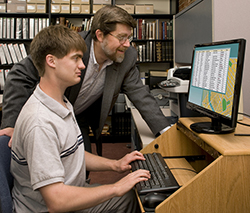Transition to Work: Program Activity Guide
The Transition to Work: Program Activity Guide was created for community rehabilitation program providers, vocational rehabilitation agencies, and teachers of students with visual impairments (TVIs) working to improve employment outcomes for teens and young adults who are blind or low vision. Youth with blindness/ low vision belong in competitive integrated jobs during and after high school like their sighted peers. For this to happen, youth with vision loss need to have an edge on the sighted students competing for the same in-demand part-time, after school, and summer jobs and this edge is only achieved if the youth receive specialized instruction in workplace readiness training no later than age 14. This is especially critical considering across the nation the age youth can begin to work ranges from ages 10 to 14. Overall, if the employment rate of teens and young adults with vision loss in the workforce is going to increase, work-based learning needs to start early, and the implementation of specialized instruction for these teens and young adults needs to be widespread.
Transition to Work: A WIOA Program Activity Guide Created Specifically for Teens Who Are Visually Low Vision
The Workforce Innovation and Opportunity Act (WIOA) requires states to reserve funds to provide pre-employment transition services to youth who are blind or low vision. Vocational rehabilitation agencies are responsible for making five required activities available to students:
- Job exploration counseling
- Work-based learning experiences
- Counseling on opportunities for enrollment in comprehensive transition or postsecondary educational programs at institutions of higher education
- Workplace readiness training to develop social skills and independent living skills
- Instruction in self-advocacy
The lessons included in this guide can be utilized by service providers to implement three of the five required activities for their blind/ low vision clients: job exploration, work-based learning, and workplace readiness training.
Emphasis on Workplace Readiness
The activities in the guide place an emphasis on students developing workplace readiness skills by requiring them to explore and hold jobs prior to the career exploration process. As teens and young adults who are blind/ low vision identify their interests and skills, they need to understand that these aspects of their character may evolve as they grow and gain work experience. Teens with vision loss need exposure to and opportunities to work in jobs to fully develop an understanding of their current skills, abilities, and interests.

Teens are often asked, “what do you want to be when you grow up?” The phrase “grow up” associated with the term “career” can be overwhelming to any student at the age of 14, regardless if they have a disability or not. This is a very complex question, and the reality is young teens who are blind or low vision are often in the process of learning what they are capable of doing. Instructors can facilitate this learning process by helping teens explore “what they want to be” through the provision of job exploration and work-based learning activities.
Emphasis on Work-Based Learning
On-the-job training opportunities, internships, and job shadowing experiences will give blind/ low vision students the opportunity to learn basic employability or transferrable skills, skills that can be learned at any job and used to pursue any career. These employment opportunities will help them determine what type of career they would like to pursue. Holding a job at an early age can also help a teen determine whether or not his future should include postsecondary education at a college or career school.
Students with vision loss who do not have experience holding a job may make premature decisions about their career path that are based solely on their perception of the career and not their actual experiences associated with holding a job. Therefore, students with low vision need to explore jobs and have employment opportunities while they are still in high school.

Blind and low vision students need experience and practice finding their own jobs. When work experiences are pre-arranged for students, they miss out on learning the skills needed to be successful in the working world. Students need to participate in the entire process of locating and obtaining a job—from completing job applications to being interviewed to starting their first day of work. Students who do not participate in the job seeking process may have misconceptions that finding and getting hired for a job is a quick and easy process. Having students find and obtain jobs on their own will help them realize that they are accountable for their employment success and give them the foundation of skills needed to independently obtain future employment.
Implementing Program Activity Guide Materials
The Transition to Work: Program Activity Guide is designed for youth whose primary (and possibly only) disability is their vision. The activities can be modified for individual student needs and for students with additional disabilities. The activities are designed to facilitate individual and small-group instruction and can also be used to facilitate distance instruction with students in rural areas when face-to-face instruction can’t occur.
The activities in the guide should be used in tandem with the Job Seeker’s Toolkit to provide comprehensive training in workplace readiness. Ideally, students should complete all of the activities in the toolkit and activity guide. Several of the activities will direct you to a lesson within the Job Seeker’s Toolkit. Users will need to register with CareerConnect to access these activities.
The activities have been numbered in a format that progresses from basic career skills to more advanced skills. However, students with vision loss should receive instruction in each skill area based on their assessed career skill needs.
The first lesson in the activity guide addresses students leading their own IEP Meetings. If students become invested in making their own decisions about their future early on, they will be more likely to become employed or attend postsecondary education. The ultimate goal is for the student to take initiative and accept responsibility and accountability in the process of planning and making decisions about their future. This process is driven by students receiving and using feedback about their performance from their teachers, counselors, family members, and other people in their personal network.
Additional activities facilitate self-exploration which will guide youth who are blind or low vision in determining if they have the skills and abilities needed to pursue college, career school, and/or employment. Students who engage in self-directed and inquiry-based learning may be more realistic about their capabilities and therefore may be more successful with their chosen direction.
Lessons Available in Multiple Learning Mediums
The lessons were developed with the intention of providing instructors easy access to a variety of activities in several formats to meet the learning medium needs of all of their students. The activities are also available as electronic braille files (BRF) in the Unified English Braille (UEB) Code ready to be embossed. The BRF files are available for download at the bottom of each lesson. Right-click and “save as” to download a file to a computer.
The Transition to Work: Program Activity Guide was developed by Alicia Wolfe for the American Foundation for the Blind.